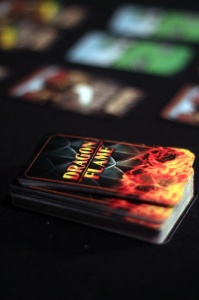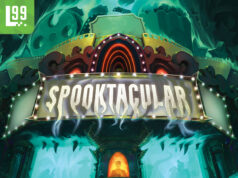Note: This preview uses pre-release components and rules. What you see here may be different from the final, published game.
 Let me start with this: dragons are awesome! And there is a new game where you get to be a dragon, I’m interested. In DragonFlame you will spend each round looting castles, capturing princesses and treasures, and burning down villages. It really is the kind of stuff dragon dreams are made of. For a game that is primarily a card game, the theme really shines.
Let me start with this: dragons are awesome! And there is a new game where you get to be a dragon, I’m interested. In DragonFlame you will spend each round looting castles, capturing princesses and treasures, and burning down villages. It really is the kind of stuff dragon dreams are made of. For a game that is primarily a card game, the theme really shines.
DragonFlame is launching a Kickstarter campaign, seeking funding for a July 2015 release. The game is primarily a set collection game, with some hidden information thrown in for good measure. Because, come on, how are you supposed to know exactly what was in that castle before you loot it? Is DragonFlame worth your Kickstarter dollars? Let’s find out!
DragonFlame is a bluffing and set collection card game for 2-5 players that takes about 30 minutes to play.
Game Overview

In DragonFlame, you take on the role of a dragon, trying to collect a more valuable hoard of treasures. Some castles will contain DragonFlame cards, which will allow you start burning down villages. You must be careful though – some castles contain curses or knights, which will hurt the value of your hoard.
So plunder castles, rescue princesses, destroy villages. Avoid the knights and curses if you can. Once all the treasure is looted from the castles, the dragon with the most valuable collection wins.
How to Play
In a two player game, each player starts with four loot cards. With three or more players, everyone starts with three. Turn order is determined randomly by any method you choose. The number of available castles will always exceed the number of players by one. Starting with the first player, he or she chooses a loot card and places it at a castle. This continues until all loot cards have been placed. However, some of the cards are placed face down. The first player will play all of their cards face up. In a five or six player game, the players in fifth or sixth turn order place all their loot face down.

Once all the loot is placed, again in turn order, each dragon chooses a castle to plunder and takes and reveals all loot cards. So while the first player gets the most options, they also know the least about which cards are really in each castle. This bit of hidden information plays out in a really interesting way, obviously not every loot card is positive. Initially, playing your bad cards face down seems like an ideal move – some unsuspecting dragon will run into the knight and lose points! But even trickier – hide the positive cards so you can hopefully pick them up while everyone else tries to avoid face down loot.
After every player has chosen a castle, the turn order is reset. Each castle is numbered, and whoever took the lowest numbered castle will become the first player next turn. This is important because the castle marked number one can hold a maximum of 2 loot cards. Castle number two can hold 3 cards. All of the other castles are unlimited. So taking a low-numbered castle will mean less loot, but more choices next round.
The game continues in this manner until the deck is exhausted. At that point scores are tallied and the winner is determined. The scoring here is a little tricky and reminds me somewhat of 7 Wonders. Whichever treasure chest you have the most of is worth the number you have, squared. If you have six blue treasure chests, you will score 36 points. Every other treasure chest you have then becomes worth negative one point. Statues are worth 5 points each, but if you get two of the same statue, they are both worth zero. Any villages that are completely destroyed score points as well. After a bit of arithmetic, we will have a total score and a winning dragon!

Game Experience
DragonFlame is really two games in one. A bluffing game where you try to mislead the other players with hidden information, and a set collection game where you try to take the cards that are most valuable to you. It plays in about 30 minutes, but while it’s more than just a filler game I found it to be light and quick enough to be accessible to many levels of players. You can go from picking it up off a shelf to having all of the rules explained in about 10 minutes. And yet, there is just enough strategy to keep it interesting up until the end.

The hidden information piece is one of the things that makes DragonFlame surprisingly fun. You will find yourself shooting a sideways glance at a fellow player who played the curse card face-down on what was an otherwise promising castle. You could play it safe and loot the first castle. It only has two cards, but at least they are face up and you know what you are getting. The premise is so simple, but even after multiple plays I don’t feel like the game has been solved.
The biggest detractor from DragonFlame is the scoring system. On one hand, it’s what makes the game. Getting a red statue when you already have a red statue will mean they are worth nothing. Getting treasure chests in all the colors is bad – only one color will score positive points and all the others will count against you. This scoring system is what makes the hidden information work.
On the other hand, it just doesn’t make any sense. The green treasure chests are Dwarven Gold and the yellow chests are full of Imperial Coins. Aren’t both of those things good? Why are my Imperial Coins bad just because I happen to have a lot of Dwarven Gold? And so what if I have two of the same statue? Can’t I just put one in storage and still get my 5 points? Not to mention its just a lot of math to do at the end – the theme abruptly ends and the calculators come out.
Final Thoughts
I ended up really enjoying DragonFlame. I played it in a 2 player game with my 8-year old daughter and a 5 player game with my normal gaming group. In both cases, everyone really enjoyed it. In general, my group loves bluffing and deduction games. DragonFlame is a nice 30 minute game that gives us a bit of that bluffing element but doesn’t feel like you are just playing another clone of The Resistance. The scoring has the potential to turn off some gamers who really draw into the thematic elements. I would recommend you give DragonFlame a try, the game play is surprisingly deep and a whole lot of fun. DragonFlame gives you the opportunity to really go for a strategy and, hopefully, watch it pay off… in the form of burning villages and stolen princesses!
If you’d like to get a copy, DragonFlame is now in funding on Kickstarter. A $25 pledge will get you a copy of the game and all stretch goals. DragonFlame is scheduled to be in backers hands in July of 2015 and you have until Thursday, December 4th to pledge. So head over today and check it out.
As always, we don’t post ratings for preview copies as the components and rules may change from the final game. Check back with us after the game is produced for a full review






















Great review! The game looks good but I agree that the scoring doesn’t sound fun. In many instances like this, we just modify the rules to fit our needs since the game play is good. Can’t wait to see the finished product.